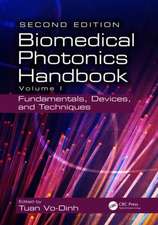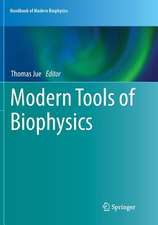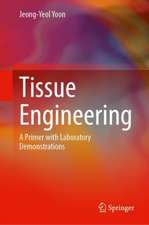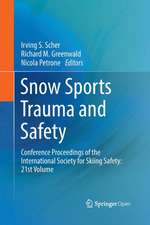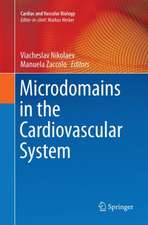Introduction to Biosensors: From Electric Circuits to Immunosensors
Autor Jeong-Yeol Yoonen Limba Engleză Hardback – 10 feb 2016
This book equips students with a thorough understanding of various types of sensors and biosensors that can be used for chemical, biological, and biomedical applications, including but not limited to temperature sensors, strain sensor, light sensors, spectrophotometric sensors, pulse oximeter, optical fiber probes, fluorescence sensors, pH sensor, ion-selective electrodes, piezoelectric sensors, glucose sensors, DNA and immunosensors, lab-on-a-chip biosensors, paper-based lab-on-a-chip biosensors, and microcontroller-based sensors. The author treats the study of biosensors with an applications-based approach, including over 15 extensive, hands-on labs given at the end of each chapter. The material is presented using a building-block approach, beginning with the fundamentals of sensor design and temperature sensors, and ending with more complicated biosensors.
New to this second edition are sections on op-amp filters, pulse oximetry, meat quality monitoring, advanced fluorescent dyes, autofluorescence, various fluorescence detection methods, fluoride ion-selective electrode, advanced glucose sensing methods including continuous glucose monitoring, paper-based lab-on-a-chip, etc. A new chapter on nano-biosensors and an appendix on microcontrollers make this textbook ideal for undergraduate engineering students studying biosensors. It can also serve as a hands-on guide for scientists and engineers working in the sensor or biosensor industries.
| Toate formatele și edițiile | Preț | Express |
|---|---|---|
| Paperback (1) | 592.26 lei 6-8 săpt. | |
| Springer International Publishing – 30 mar 2018 | 592.26 lei 6-8 săpt. | |
| Hardback (1) | 788.68 lei 6-8 săpt. | |
| Springer International Publishing – 10 feb 2016 | 788.68 lei 6-8 săpt. |
Preț: 788.68 lei
Preț vechi: 830.18 lei
-5% Nou
Puncte Express: 1183
Preț estimativ în valută:
150.92€ • 157.89$ • 125.36£
150.92€ • 157.89$ • 125.36£
Carte tipărită la comandă
Livrare economică 02-16 aprilie
Preluare comenzi: 021 569.72.76
Specificații
ISBN-13: 9783319274119
ISBN-10: 3319274112
Pagini: 331
Ilustrații: XV, 331 p. 336 illus., 110 illus. in color.
Dimensiuni: 155 x 235 x 25 mm
Greutate: 0.66 kg
Ediția:2nd ed. 2016
Editura: Springer International Publishing
Colecția Springer
Locul publicării:Cham, Switzerland
ISBN-10: 3319274112
Pagini: 331
Ilustrații: XV, 331 p. 336 illus., 110 illus. in color.
Dimensiuni: 155 x 235 x 25 mm
Greutate: 0.66 kg
Ediția:2nd ed. 2016
Editura: Springer International Publishing
Colecția Springer
Locul publicării:Cham, Switzerland
Public țintă
Upper undergraduateCuprins
Introduction.- Resistors.- Diodes and Transistors.- Temperature Sensors.- Wheatstone Bridge.- Op-amp.- Light Sensors.- Spectrophotometry.- Fluorescence.- Electrochemical Sensors.- Piezoelectric Sensors.- Glucose Sensors.- Immunosensors.- Lab-on-a-chip Biosensors.- Nano-Biosensors.
Notă biografică
Jeong-Yeol Yoon received his B.S., M.S., and Ph.D. degrees in Chemical Engineering from Yonsei University, Seoul (South Korea) in 1992, 1994, and 1999 respectively, under the guidance of Dr. Woo-Sik Kim, in collaboration with Dr. Jung-Hyun Kim, where he worked primarily on polymer colloids. He received his second Ph.D. in Biomedical Engineering from the University of California, Los Angeles (UCLA) in 2004, working on lab-on-a-chip and biomaterials, under the guidance of Dr. Robin L. Garrell. He joined the Agricultural & Biosystems Engineering faculty in August 2004 and holds joint appointment in the Department of Biomedical Engineering and BIO5 Institute at the University of Arizona. Dr. Yoon is currently Professor and is directing the Biosensors Lab (http://biosensors.abe.arizona.edu). He is a member of the Institute of Biological Engineering (IBE), American Society of Agricultural and Biological Engineers (ASABE), and SPIE—The International Society for Optics and Photonics. Hewas an elected president of IBE (http://www.ibe.org) for the 2015 calendar year. Dr. Yoon currently serves as one of two Editor-in-Chief’s for Journal of Biological Engineering (http://www.jbioleng.org), the official journal of IBE, published by BioMed Central. He also serves (or had served) as Associate Editor and Editorial Board Members for numerous journals, including Scientific Reports, Journal of Biological Engineering, Biological Engineering Transactions, and Transactions of the ASABE.
Textul de pe ultima copertă
This book equips students with a thorough understanding of various types of sensors and biosensors that can be used for chemical, biological, and biomedical applications, including but not limited to temperature sensors, strain sensor, light sensors, spectrophotometric sensors, pulse oximeter, optical fiber probes, fluorescence sensors, pH sensor, ion-selective electrodes, piezoelectric sensors, glucose sensors, DNA and immunosensors, lab-on-a-chip biosensors, paper-based lab-on-a-chip biosensors, and microcontroller-based sensors. The author treats the study of biosensors with an applications-based approach, including over 15 extensive, hands-on labs given at the end of each chapter. The material is presented using a building-block approach, beginning with the fundamentals of sensor design and temperature sensors, and ending with more complicated biosensors.
New to this second edition are sections on op-amp filters, pulse oximetry, meat quality monitoring, advanced fluorescent dyes, autofluorescence, various fluorescence detection methods, fluoride ion-selective electrode, advanced glucose sensing methods including continuous glucose monitoring, paper-based lab-on-a-chip, etc. A new chapter on nano-biosensors and an appendix on microcontrollers make this textbook ideal for undergraduate engineering students studying biosensors. It can also serve as a hands-on guide for scientists and engineers working in the sensor or biosensor industries.
Caracteristici
Provides over 14 extensive, hands-on labs at the end of each chapter, many of which are new to the second edition, delivering hands-on guidance and visual demonstration of biosensor applications Takes a step-by-step approach toward the end result of building an antibody-based immunosensor from scratch Includes new material on glucose sensors and microcontrollers for biosensors as well as new lab exercises such as building an op-amp circuit for commercial glucose strips, quantifying lateral flow assays (pregnancy tests) with a smartphone, and building a pulse oximeter (LED+PD circuit) Includes supplementary material: sn.pub/extras





